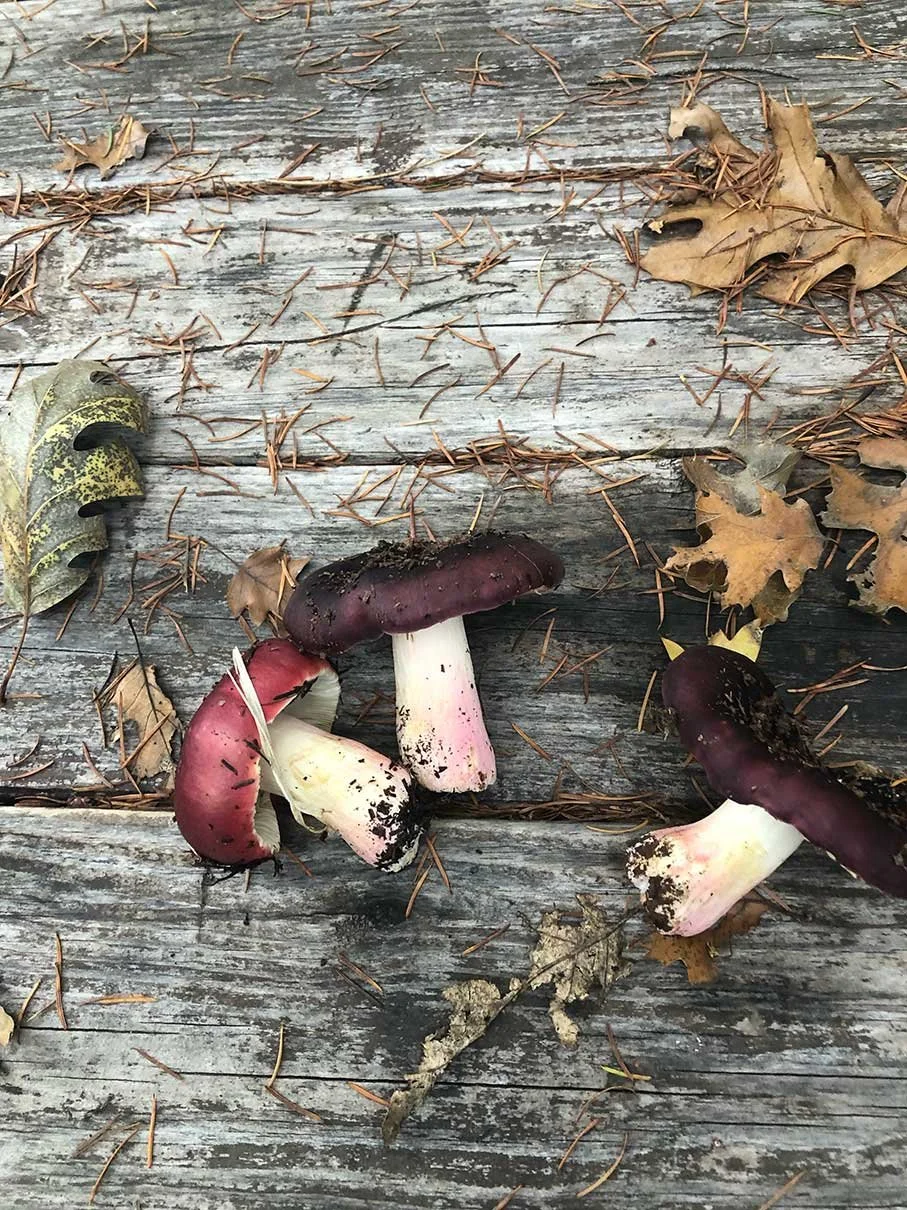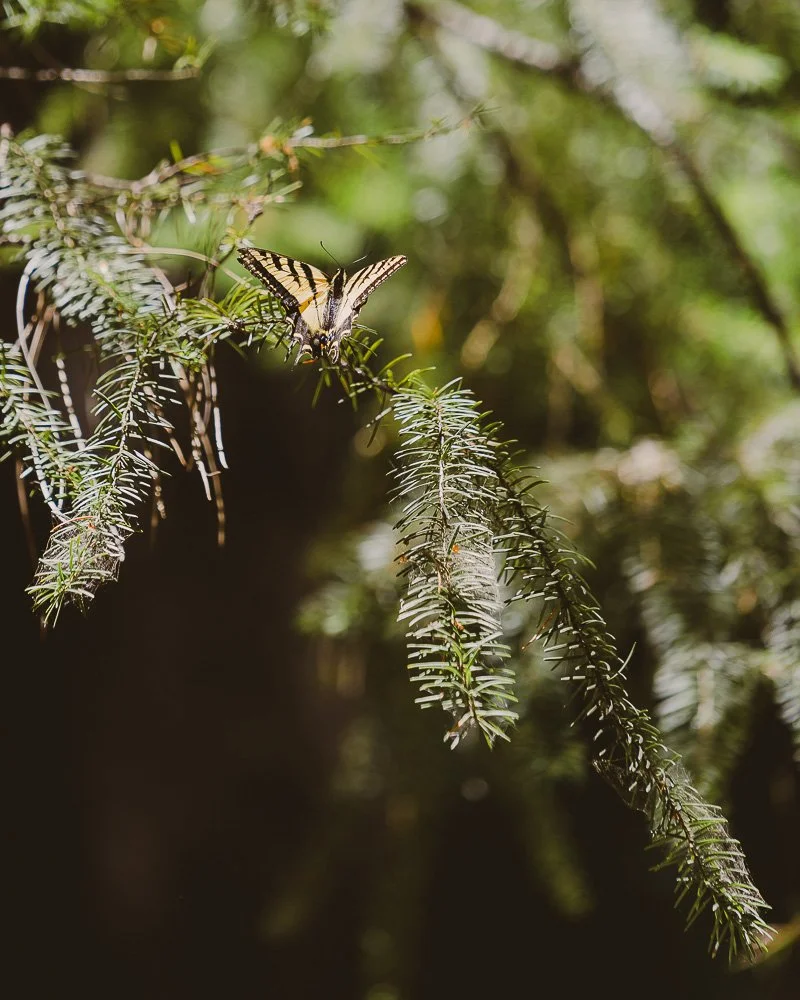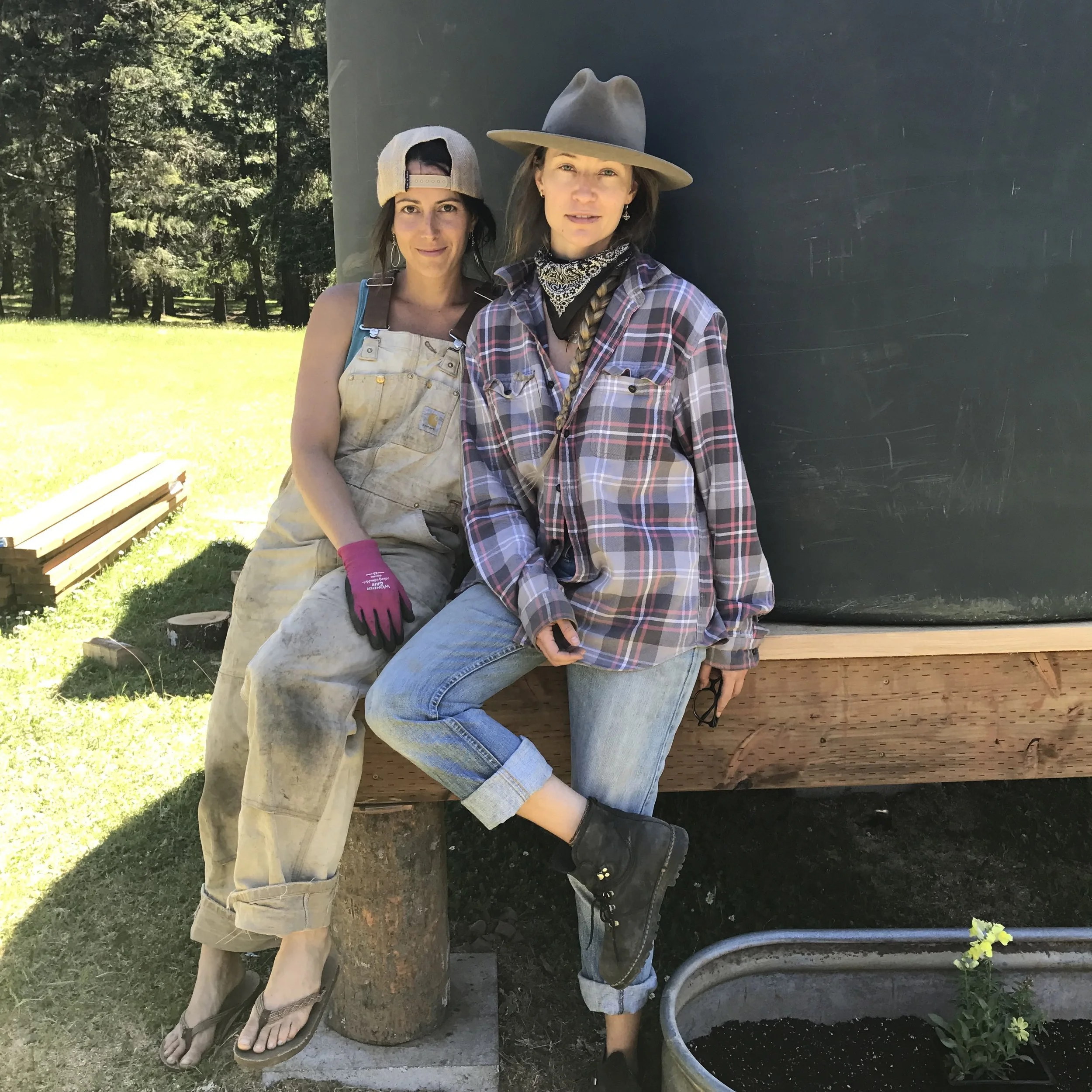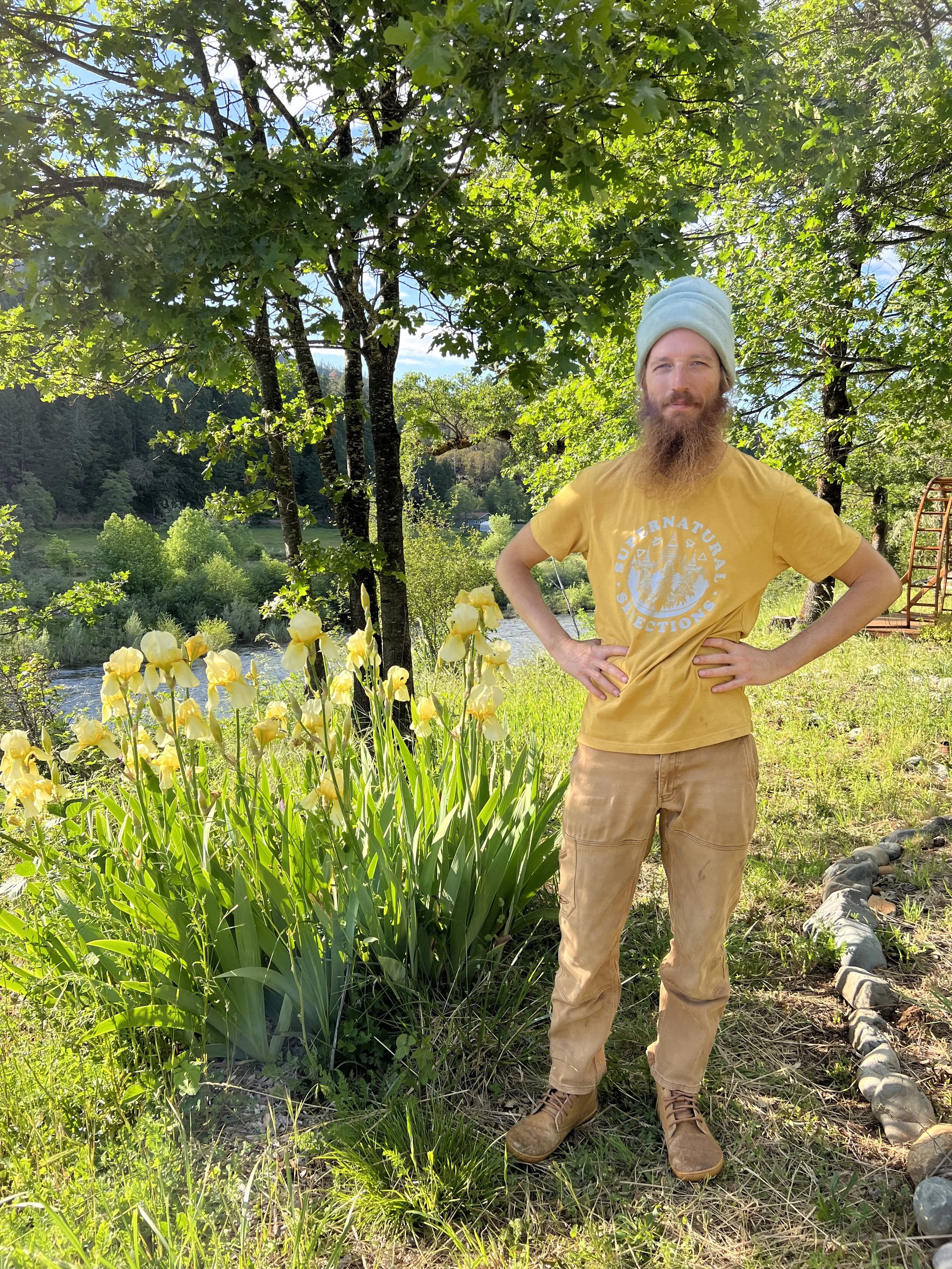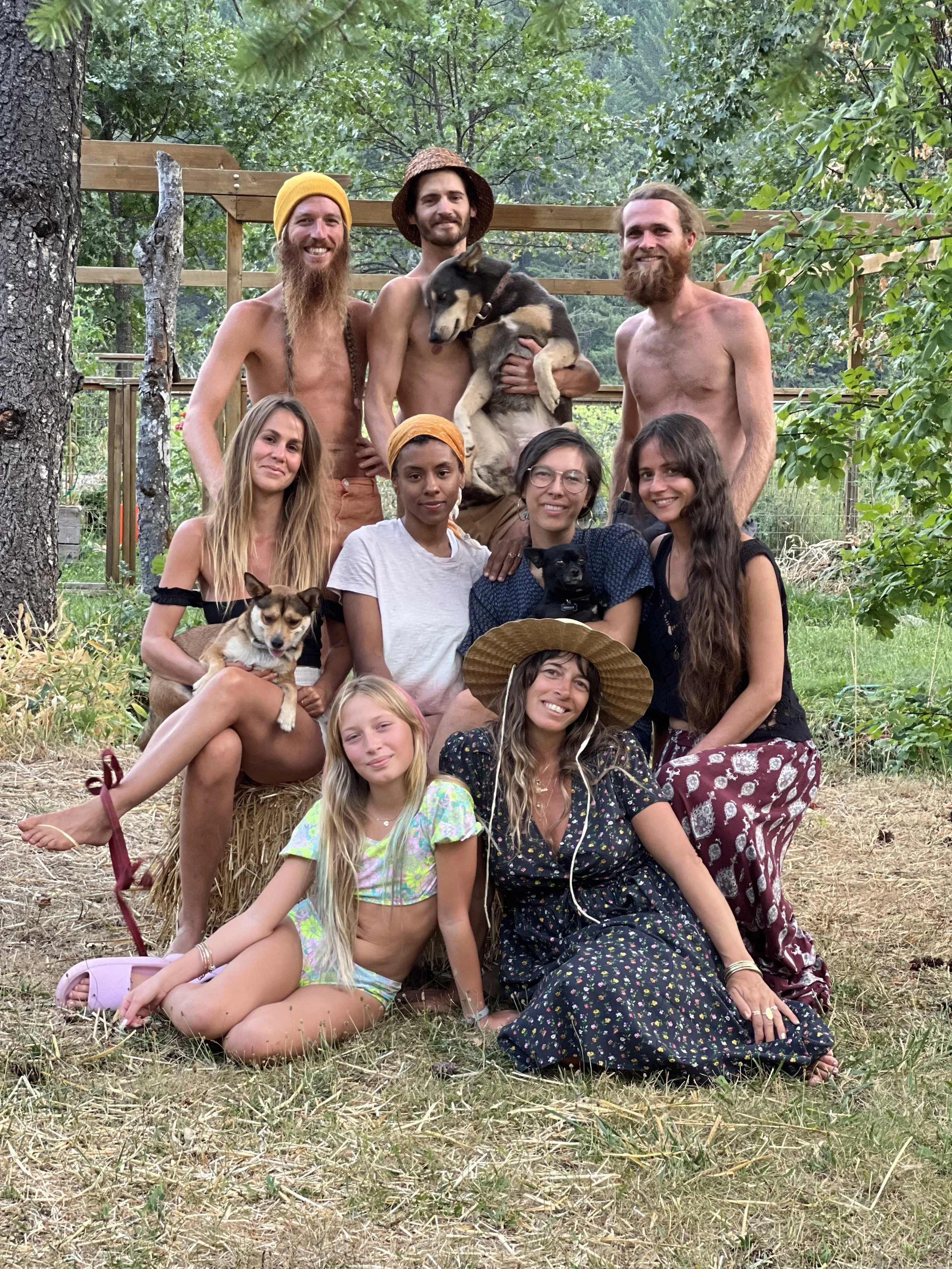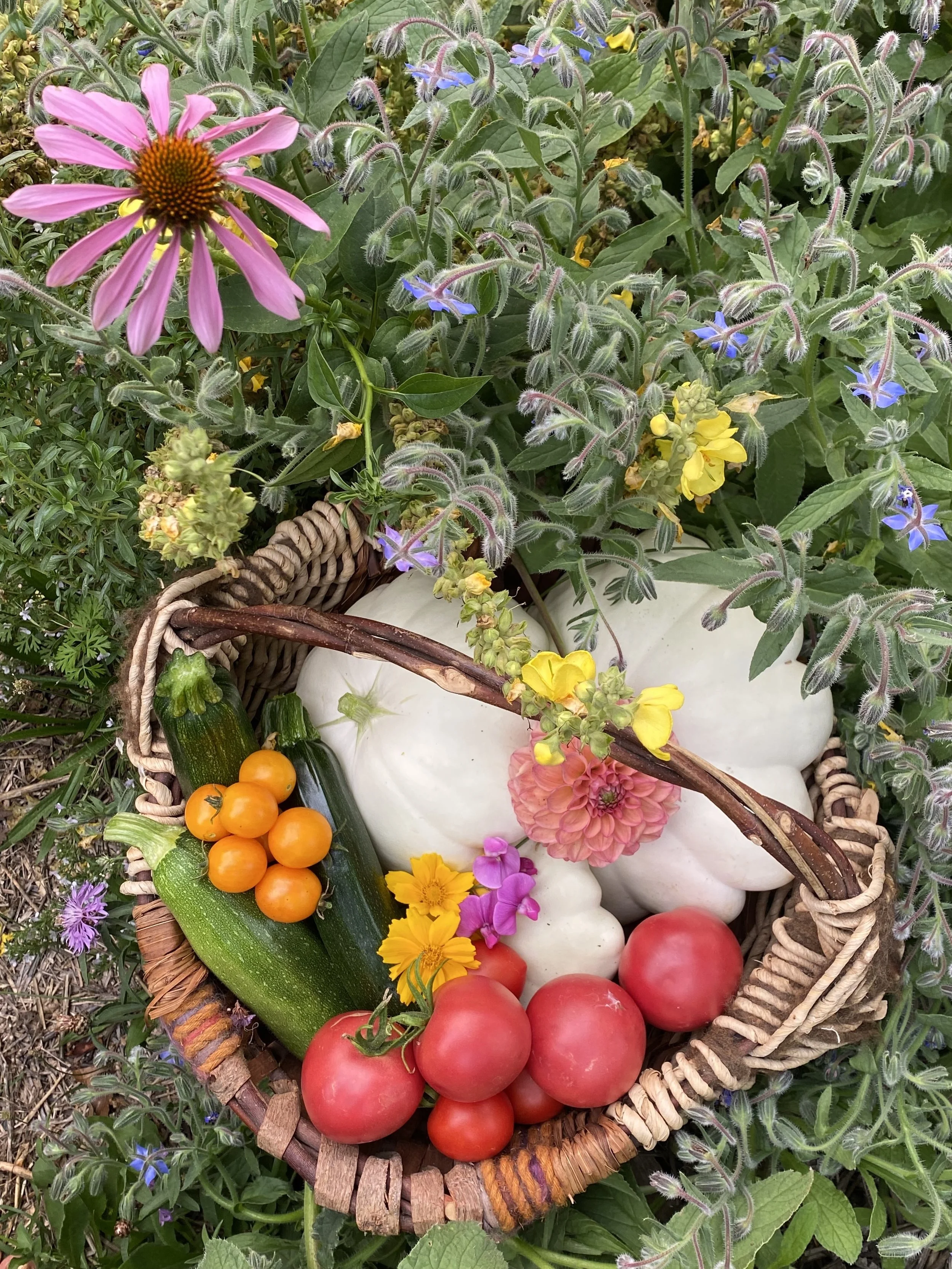grateful for our
Land & Community



The Land
Located in the Illinois Valley
Located in the Illinois Valley of Southern Oregon, we are 99 acres of forested land, nestled alongside the Illinois River, just east of the Rogue River and Siskiyou National Forest. The climate and biodiversity of this area over time have created a very abundant environment for a wide variety of plants and animals to thrive, and therefore, a home to humans for a very long time.
We feel honored to be stewards of this land. One of our main visions for this land is to protect its cultural and environmental heritage. We are excited to share about the native food forest we will be cultivating for the local community and beyond.
We will also be placing the land into a conservation trust so no logging or future development can occur. For many years to come, we will explore the ways can live in harmony with the natural world for the greater good of people and the plants and animals we depend on.
The Takelma People
Cedar Bloom sits on the original land of the Takelma People. We have an understanding of the privilege and give thanks daily for the opportunity to be in connection with these lands. We are in a continuing relationship of educating ourselves through connection, listening, research, and story sharing with the Takelma people of the Illinois River valley region. We are committed to continuing to build relationships and welcome all Takelma people to share their story and visit these lands to be held and honored amongst the forest and human kin that dwell here.
Jennie, a Rogue River Takelma woman, who crafted the dress worn in this iconic Peter Britt portrait.
For thousands of years, the Takelma people lived in the Illinois and Rogue River valleys, what is now known as Josephine County. They lived in small bands close to the land.
Salmon was central to their food source and way of life. The salmon diet was supplemented by game, such as deer, elk, beaver, bear, antelope and bighorn sheep. Smaller mammals, such as squirrels, rabbits and gophers, might have been snared by both men and women. They gathered the root of the Camas plant, part of the asparagus family, as well as acorns from the two native species of Oaks, the Oregon white oak and California black oak. Other vegetation included manzanita berries, pine nuts, tarweed seeds, wild plums and sunflowers. The Takelma are also known to have cultivated a native tobacco plant, but otherwise relied on the fruits of the wilderness for their survival. The main utensils included horn, bone and wood-made implements and a great variety of baskets constructed generally by twining on a hazel warp. Stone was used in the making of arrowheads and pestles. The clothing and personal adornment of the Takelma was similar to the tribes of northern California. Notable characteristics include facial painting, red-headed woodpecker scalps for men and basket caps for women. The women also tattooed the skin in three stripes and men tattooed the left arm.
European Settlement of the Illinois Valley began by the 1830’s, as the gold and logging industries developed. By the end of 1856, the traditional residents of the Rogue and Illinois River valleys were forcibly removed and relocated to both the Siletz Reservation on the central Oregon coast, and the Grand Ronde Reservation. The Takelma were joined on the reservations by their neighbors, the Athapaskans and the Shasta, as well as tribes from even farther away, such as the Coos and Tillamook. It is reported that by 1906 less than ten Takelma were alive and able to speak their native language.
Group of Takelma Native American Women and Children, Oregon, circa 1880.
In 1954, one hundred years after the western Oregon Indians were removed to the Grand Ronde Reservation; the indigenous peoples were subjected to the final effort by the United States to colonize the remainder of their lands through Federal termination policy. The permanent Grand Ronde Reservation, settled in 1855 and established by presidential executive order in 1857, was terminated by Congress, and the tribal people lost their Federal recognition. The seven ratified treaties that ceded to the United States millions of acres of land, most of western Oregon, which was occupied by over 60 tribal nations, were nullified. These 60 tribes were declared by Congress to be assimilated, and termination was enacted to free them from continued government management and oppression. In western Oregon, native people appeared to cease to exist, and for 29 years the Grand Ronde descendants suffered disenfranchisement and a multitude of social problems. The reservation’s tribal cultures, languages, and community were severely fractured and much was lost. Terminated tribal members were rejected by other tribes as having willingly sold out to the Federal government. During the post-termination era, despite all of the problems the tribal members faced, they found ways to survive and worked to restore the tribe. In 1983, the Grand Ronde Tribe was restored.
Source: Lewis, David Gene. “Termination of the Confederated Tribes of the Grand Ronde Community of Oregon: Politics, Community, Identity.” Order No. 3356586 University of Oregon, 2009. Ann Arbor: ProQuest. Web. 29 Oct. 2019.
The restoration of the Grand Ronde Reservation in 1983 was made possible entirely through grassroots efforts by indigenous peoples and their allies. These grassroots efforts are the culmination of exhaustive efforts to solidify the space for indigenous people to carry their way of live forward.
In 1994, for the first time in over 140 years, an ancient ceremony took place to welcome home and give thanks for the returning salmon, on the Kanaka Flats of the Applegate River. People of all heritages were welcomed at the annual Salmon Gathering on the Applegate River until 2006. In 2007, the ceremony was moved to the place where it was held for thousands of years: the Tilomikh (Powerhouse Falls), on the Rogue River near Gold Hill, Oregon. Since then, the ceremony has taken place annually in its traditional location, demonstrating that the Takelma culture is alive and will continue into the future.
In 2019, Members of the Confederate Tribes of Siletz Indians celebrate Indigenous People’s Day, hosted by Southern Oregon University for native students, nonnative students, and community members. After a traditional salmon bake and ceremonial music performance, an Intergenerational Activism Panel concluded the event.
It’s imperative that as settlers of these lands, we both acknowledge and support the continued efforts of the local tribes who first stewarded this land, and continue to live and thrive in Southern Oregon today.
Today, Takelma descendents continue to reside on or near the Siletz and Grand Ronde reservations. The Pilgrims brought back the Salmon Ceremony to Southern Oregon. Due to the Pilgrim’s contribution in returning the Salmon Ceremony to Jackson County, Agnes Baker-Pilgrim was known to locals as the ‘Keeper of the Sacred Salmon Ceremony. Agnes, one of the oldest grandmothers of the International Council of the 13 Indigenous Grandmothers, returned to the Rogue Valley to be with her land and people. We were deeply honored to have Grandma come to share stories and to do a land blessing for Cedar Bloom. In September of 2019, we hosted Grandma’s 95th Birthday at Cedar Bloom. Her family joined us from near and far. We gifted Grandma a mural of herself painted by Artist Maggie Lochtenberg. There was song, ceremony and celebration. Grandma Aggie left our earth plane just a few months later on November 27, 2019. Her voice can be heard strong and clear, proving that the spirit and blood of her people are still with us.
You can donate to Grandma’s Legacy Fund here:
✿ Shifting Seasons ✿
Interior southwest Oregon has pronounced seasons, and the ancient Takelma adapted to these seasons by spending spring, summer and early fall months collecting and storing food for the winter season. Cedar Bloom is nestled in what are now named the Siskiyou Mounatins and are one of the most bio-diverse in the Planet.
SPRING
The magic and depth of the forest stretch in every direction. The ideal Springtime weather will reveal subtle rainbows of forest flowers accenting the endless beauty of this exquisite land. A variety of tree cathedrals, grasslands, river front meadows, and outdoor sleeping arrangments are just a handful of the incredible offerings of this sacred land.
SUMMER
Hot and dry summer days at Cedar Bloom are spent swimming and playing in the Illinois River, which runs for almost a mile upon the shores of the land, and is a hidden gem amongst the valley. We have been told that the land holds one of the best swimming holes in all of Southern Oregon!
AUTUMN
As the seasons shift and the days get shorter, the land becomes a peaceful sanctuary for animals and people alike to rest and soak in the last of the summer sun. The land becomes ripe with medicine of the fall, such as elderberries and mushrooms, and all beings gather themselves for winter.
WINTER
The beauty and stillness of this natural forest sanctuary makes it the perfect place to retreat, renew, and reconnect with nature and each other. Winter is the perfect time for personal retreats. Whether you're resting and processing your year, or writing an epic novel, the land is quiet, and ready to hold you.
Plant and Animal Relations
We are very fortunate to be surrounded by a widely diverse population of flora and fauna. As caretakers of this sacred land, we feel a strong responsibility to honor our plant and animal allies by not only protecting them and their habitat, but also to help educate others about what lives and grows here by providing people with opportunities to experience the beauty of these plants and animals for themselves.
For this reason, We are honored to host the many different groups who will gather here on this land for learning and communing with the nature that flourishes here. We feel very fortunate to be involved in this process of helping promote a sustainable and abundant future for all living things on this planet by sharing knowledge and skills from the human past that can make a sustainable lifestyle a reality for everyone everywhere.
The animals here include, but are not limited to deer, foxes, coyote, raccoon, skunks, and sometimes black bear. The birds that surround us are migratory geese, quail, wild turkeys, hawks, ospreys and eagles. The fish that call the Illinois River their home are the Salmon People, Steelhead & Trout along with their friends the otter and ducks. The Land is a no-hunting zone so the animals here are abundant and comfortable with our human presence.
The plant life here is incredibly diverse. This land is home to many native grasses, ferns, and berries, wild flowers, as well as many other edible and medicinal plants and fungi such as mugwort, self-heal, elderberry, roseships, hawthorn berries, blackberries, willow, soap root, and a variety of mushrooms. The tree community is a blend of hardwoods like Manzanita, Madrone, and several kinds of Oaks along with mature Fir, Pine, Cedar trees, Alder, Maple and Apples. With special attention to management of non-native and invasive plants, we are committed to maintaining a well balanced forest ecosystem with high biodiversity.
As stewards of these lands, we at Cedar Bloom continue to deepen our relationship to the flora and fauna of this region. We strive to be in a harmonious ecosystem through aliveness and reciprocity.

Our Main Event
Spirit Weavers Gathering
Our Community
Stewarding 99 acres of land takes a village, and we are fortunate to have four year round residents, tending full time, and our dear sister across the river. Ben, Nenah, Matt, Samantha, and Kelsey live each day deepening their relations to the land, the Beings, and supporting the needs of Cedar Bloom. We are all nature enthusiasts hailing from California, Florida, and south London. We tend to the forest asking the questions, “what does the land need?” and “How do we deliver with grace?
Cedar Bloom also has the support of friends, family, and work traders who generously give their time and hearts to supporting the needs of our ongoing projects. We are grateful for our supportive network of community to make our land stewarding dreams and visions come to fruition.
Summer Worktrade
Stewarding 100 acres of land, hosting guests and events can not be done without the hands of many people. At Cedar Bloom we welcome folks to join us through our work exchange program, offering opportunities to give and receive land tending practices and knowledge. People interested and/or having experience in skillsets such as gardening, carpentry, hospitality, permaculture, natural structure builds, and regenerative forestry are welcome to connect with us about the possibilities of growing and devoting time with us at Cedar Bloom. The projects at hand and where you may spend most of your time are dependent on the season and most importantly the needs of the land.
We feel honored to be stewards of this land as it is truly a hidden gem in Southern Oregon. The land holds meadows, trails, swimming holes and so much more. We are totally secluded yet only a few minutes from the town of Cave Junction. We are located just off the 199 Redwood Highway.
Our place is filled with thousands of trees including Cedar, Pine, Doug Fir, Oak, and Madrone. The land includes a commercial kitchen, sauna, two bathhouses and lots of privacy. You are welcome to bring your own camping gear or stay in one of our canvas tents during your time here! There are 4 full time residents on the land, while during Spring through Autumn, our small community usually doubles and sometimes more with family, friends, and work Exchange folks coming to join us on the land.
Types of Help Needed
-
We have a lot of facilities that appreciate the extra love! This includes regular maintenance of the cabins and communal kitchen, as well as specialty projects that come up.
-
Checking in campers as they arrive and giving them a quick tour of the land. Assisting in camp store purchases and providing a wonderful cedar bloom experience. This role often goes hand in hand with cleaning help and maintaining the frequently used facilities as well as cleaning any necessary sleeping accommodations on your shift.
-
We need experienced helping hands to help us grow our gardens and prep our farm! We are expanding our current communal, flower, medicinal plant gardens and are calling in the gnomes to help make the vision unfurl. This includes weeding, digging, planting and daily watering. We are also looking for people who want to help improve the soil of some future farmland, as well as plant cover crops. Irrigation and any permaculture knowledge experience is a plus, but not necessary.
-
Do you have mindful forestry experience? Are you familiar with controlled burn practices for biochar? With 100 acres of Forest we always need support with felling and limbing trees, and tending to the over and understory. Chainsaw experience necessary, as well as previous experience.
-
99 acres of land means there is always something to tinker with or maintain, and we always are thinking of new. If you are solution based and work with tools, we have many tasks for you Some examples of this work would be fixing things like a clogged sink, shower filters, various pumps, A frame maintenance, painting. May include occasional bigger plumbing, installing, and facility repair.
-
We love making the forest our gym and so can you. Some examples of physical tasks like clearing tree branches in the forest, digging holes, chopping and stacking wood, turning compost, burn piles, moving wood chips, clearing & establishing hiking trails, broadforking soil, putting in fence posts.
-
We are always dreaming and living in the possibilities and this often requires some small building of something. It may be a chicken coop, perhaps a small tool shed, maybe a roof over a woodstack, or even a new deck. If you have building skills, design dreams and some experience, this would be a place for you to thrive. Inquire with us to find out what we have planned for the upcoming seasons
-
We'd love to add new structures to the land including a cob oven and staff housing. If you know how to work with earth, rocks, and other natural materials in an artistic and experienced manner, we would love to hear from you. Having worked with materials best suited for the Pacific Northwest climate is certainly a plus.
-
We have big dreams. We live in the possibilities. We want to be in service to the Earth and provide for the community. This requires help and support from the heart, and realistically financially. We want to expand our growing opportunities, we need water pumps to help those seeds grow. To continue a small footprint self reliable farm and forest, we need small amounts of livestock, goats, sheep, chicken, ducks, and they all require appropriate shelter and feed. We need solar power. These are some of the elements that will take us to the next level of enriching our relationship to the earth and the community. We know there is funding available to help with these dreams, we just need the writer to get the info to those people. If you have experience or know where to start, connect with us.
Worktrade FAQ
-
We welcome work traders beginning Spring-Fall.
-
Depending on the time of year, we have a 16ft geodesic dome, a small vintage trailer, 12ft Canvas Bell Tent. If you have your own on the road home, we welcome that too. Although, we do not have RV hook ups available.
-
We provide the basics to make some great meals. You will have access to what is freshly growing, as well as some staples grains, legumes, spices and seasonings.
-
As part of the work trade team, you have access to all amenities on Cedar Bloom, a mile of river access, sauna, river overlook showers, teahouse, gardens, communal kitchen, 99 acres of forested land.
-
Depending on the season, it can be planting seeds, preparing soil, tending compost, greeting guests, maintaining facilities, pruning trees and trails, building projects, splitting wood, just to name a few.
-
Generally our work trade program asks folks for about 2-3 days totalling 18-20 hours a week to contribute to the Land in exchange for staying on the land with us.
-
We are open to the needs of each person in alignment with Cedar Bloom’s needs. We ask for a minimum of a two week stay with us and to fully commit to that time.
Our Story
Aloha!
We are Agustin, Mea and Naia, a small family of three who have been living on the island of Kauai for the last sixteen years.
Mea founded and organizes the Spirit Weavers Gathering, an annual women's gathering in its 12th year. The Gathering spent it's first 4 years in California, but had been dreaming of finding a permanent home. After five years of searching for the perfect land, we found Cedar Bloom through a dear friend who had lived on a community directly next door.
In the Spring of 2017, The Spirit Weavers Gathering bought Cedar Bloom from a family who had owned the land for the last 60 years. Cedar Bloom was everything we had been searching for.
Mea was born and raised in Southern California on a family farm. Her family spent most of their time outdoors raising animals and growing food. Camping throughout the year was a common occurrence. You can find Mea at @daughterofthesun_
Agustin spent his youth in Kansas but lived in Southern Mexico and South America throughout his twenties. Agustin has been playing music since his teenage years. You can find him through his newest project @kunzitemusic.
Naia our fourteen year old daughter is home schooled through a program on Kauai and loves to surf, dance, play the piano, shelling and time spent in the ocean. We live on Kauai most of the year, but spend our Summers at Cedar Bloom. We look forward to receiving you on the land and sharing the beauty of Southern Oregon with you.















































